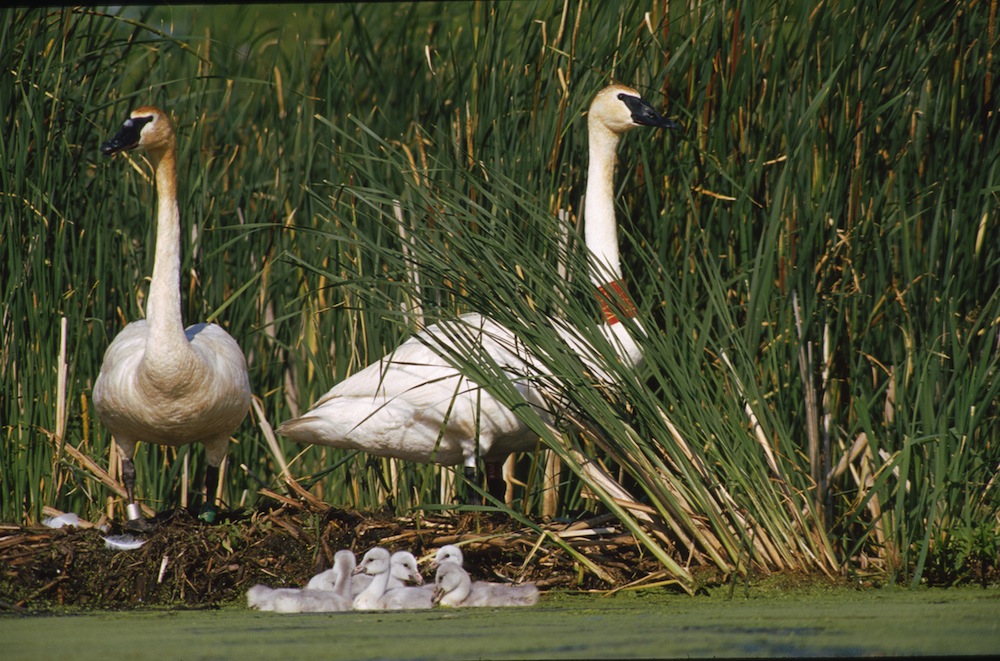The fall and rise of trumpeter swans in North America is an amazing story – nearly wiped out by settlers crossing the country, turning virgin prairie and wetlands into farmsteads and farm fields. These settlers exported more than 100,000 trumpeters between 1880-1920 to use in products like quill pens, powder puffs, pillows, quilts and hats. The swans’ meat and eggs were consumed as part of the pioneer diet.
During this time, Iowa settlers began draining wetlands as the journey to become an agricultural state was underway, leaving only a few silt filled marshes with little value to wildlife. In the end, 98 percent of Iowa’s prairie wetlands would be drained and the last nesting pair of trumpeter swans was lost from what would later become the Twin Lakes Wildlife Area in Hancock County, in 1883.
At a low point in the 1930s, a nationwide survey found only 69 trumpeter swans remained in the lower 48 states, all in southwest Montana. No trumpeter swans called Iowa home for the next 112 years.
A significant undertaking began in 1993 when the Iowa Department of Natural Resources and its local partners developed a plan with the goal of restoring a self-sustaining migratory population of trumpeter swans in its native range – primarily in the north central region among Iowa’s prairie potholes.
The restoration effort released more than 1,150 trumpeters beginning in 1995 with more than 90 percent going to the PPR. It was around this time when the DNR and its partners were working to restore wetlands and shallow lakes and the swan project took off.
As the swan population approached sustainable levels in north central and east central Iowa, the swan team reduced the number of releases and turned its focus to increasing the number of restored wetlands, improving water quality and habitat restoration. Their goal was to get wetlands back to a healthy state so they could serve as a natural filter to improve water quality, aid in flood control and provide rest stops and refueling stations to migrating birds.
These restored areas quickly became magnets for the swans. Of the 45 nesting pairs documented in 2014, all but eight are in the PPR.
Shallow lakes projects and renovations at Diamond Lake, Dan Green Slough, Virgin Lake, Big Wall Lake, Four Mile Lake, Lizard Lake, Silver Lake Burr Oak Lake and others not only attracted trumpeter swans, but species that require high quality habitat–like black terns, horned grebes, eared grebes, red-necked grebes and western grebes–and large numbers of diverse migrating waterfowl.
A common link among each of these projects was the improved ability to manage water levels.
Each renovation became a showcase in gaining support for the next; turning initial reluctance from nearby residents into support and understanding that these areas needed to be actively managed to replicate natural cycles. The results showed without a doubt that these shallow lakes with high turbidity, exotic rough fish and little aquatic plant life could become high value systems once again.
Returning trumpeter swans to the Iowa landscape is significant because these big beautiful birds were here long before Iowa became a state. The diversity of wildlife returning to these restored wetlands and shallow lakes is indicative of an improving environment. These benefits add to our quality of life, which is an important economic development factor for recruiting and retaining a high quality, dynamic workforce.
The hard work and focused 20 year effort to restore the potholes and return the trumpeter swan to Iowa’s prairie wetlands will be showcased as part of the U.S. Fish and Wildlife Service’s five-year North American Swan Survey that begins this year.
For more information, contact Dale Garner, Ph.D., Iowa Department of Natural Resources’ Wildlife Bureau Chief, Dale.Garner@dnr.iowa.gov
News

Trumpeter Swans Flourish in Shallow Lakes of Iowa
- PPJV
- June 2, 2015
